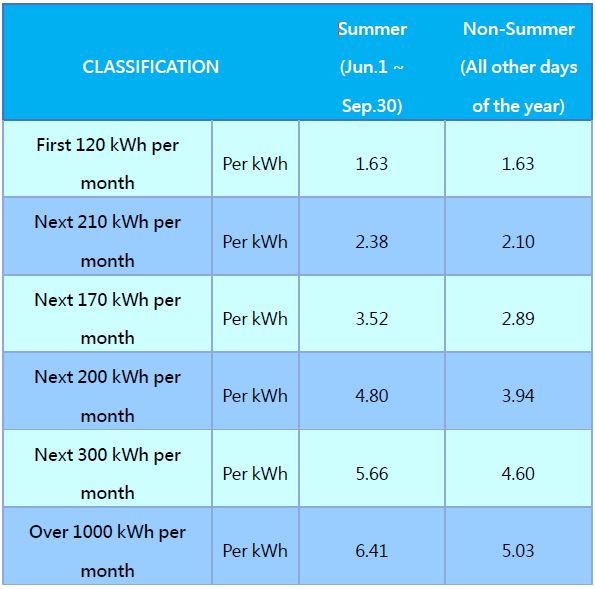Q & A
Q1.Why the increase/decrease of electricity fee is not defined by comparing it with the previous period?
Due to the influence of seasonal factor, users may feel that the electricity fee has been increased in comparison with the previous period when receiving the electricity bills. But if it is compared with the same period last year, the seasonal factor can be offset and the fluctuation of electricity fee can be more clearly illustrated.
Q2.Why the cost of electricity fee increase so much in summer?
It is more reasonable to compare the electricity fee with the same period last year.
In summer electricity usage and electricity rate will be increased, so users tend to feel that the cost of electricity fee increase enormously.
The electricity rate in summer applies from 1st of June every year since 1989 till now. And non-summer electricity rate applies after 1st of October.
.jpg)
Q3.Is the electricity price cheaper for residential users at night?
Residential users can choose Non-Time-of-Use Rate (i.e. progressive electricity rate; same price during peak or off-peak) or Time-of-Use Rate (different price during peak or off-peak). For progressive electricity rate, the usage is charged based on different usage stages. For time-varying electricity rate, the cost of electricity fee per month is the sum of demand charge and energy charge. Generally speaking, residential users’ electricity usage is comparatively less and their off-peak usage (22:30~07:30) is not much, so normally progressive electricity rate is chosen, in which the unit price of electricity increases along with the increase of usage levels. There are 6 stages rates and no difference between peak and off-peak charges (as illustrated in the table below). Take summer rate as an example, assume that the monthly electricity usage is 434 kwh, among which the unit price for the usage of 120 kwh is $ 1.63, the unit price for the usage of 210kwh (330-120) is $2.38, and the unit price for the remaining usage 104 kwh (434-330) is $3.52. To sum up, the cost of electricity fee is related to electricity usage rather than the time when the electricity being used.

Meter Rate Lighting Service (Non Time-of-Use & Non-commercial rate) applies from 1st of April since 2018
In order to carry out government’s policies regarding taking care of people and facilitating energy conservation & carbon reduction, the unit prices of first and second usage stages in non-time-of-use rate have been set at lower levels for a long time. And when price adjustment was enforced from 2018/04/01, the unit price of the usage under 500 kwh remained unchanged, so it seems better for most residential users to choose non-time-of-use pricing.
Q4. Why should electricity users set contract capacity and pay for the demand charge?
Since electricity cannot be stored, we need to arrange enough equipment for required power generation based on users’ contract capacity in order to meet users’ need at any time. Once the equipment is being invested and installed, whether the power generated is used by users or not, the fixed costs concerning operation, maintenance or depreciation of the equipment shall still incur. Therefore, even users’ actual usages are under the contract capacity, the demand charge still needs to be paid so as to recover the fixed costs of our company.
For this reason, users should consider the usage timing and capacity of their appliances and devices to set appropriate contract capacity. We provide contract capacity evaluation services in our branches.
Q5.Why extra costs should be paid when electricity usage exceeds contract capacity?
In order to prevent users’ electricity usage from exceeding the contract capacity which endangers the stability of power supply due to insufficient supply or circuit burnout, we should arrange for extra power supply capacity to respond to such cases. However, it is not fair if the extra power supply cost generated from over-contract-capacity-usage of some users is transferred to the whole users. Thus, it is reasonable and fair that such cost should be paid by over-contract-capacity-users only.
Considering the power supply equipment installed for extra demand is not frequently used, the fixed cost of such equipment shared by each over-contract-capacity-usage is comparatively higher and an additional demand charge will apply. For example, four people rent a car; if two more people intended to participate in the carpool, a bigger car or another car shall be rented to avoid overload. The additional cost shared by the added passengers will be higher than the original rent shared by per passenger. In this logic, the extra fee charged for over-contract-capacity-usage is actually not a penalty but a necessary measure to fairly reflect the actual cost, avoid unfair cost transfer, prevent system overload, maintain the power supply safety of the equipment and protect public rights in using electricity.
The mechanism which prevents user’s over-contract-capacity-usage with additional demand charge is also applied in international power industries. A demand charge which is as much as 12 times that of the original one is even charged in some countries. In Taiwan, the over-contract-capacity-usage charge is as much as two times that of the original demand charge (i.e. the original demand charge plus one more demand charge) for over-usage within 10% of the contract capacity. An over-contract-capacity-usage charge is as much as three times that of original demand charge (i.e. the original demand charge plus two times of demand charge) for over-usage over 10% of contract capacity. The burden of over-contract-capacity-usage on users in Taiwan is comparatively lighter than that applied in other countries.